Black grape varieties: an overview of the best table and technical varieties, their taste and characteristics
Recently, black berry grape varieties have become more and more popular. This can be largely explained by the fact that in red (black) grape varieties, many vitamins (in particular, the PP group) are contained in larger quantities than in white or pink... A huge number of summer residents plant multi-colored varieties, if only because they really want to make their garden more interesting, so to speak, so that it has color contrasts.
Further, you will not only find out, but also see which black grape varieties have gained the most popularity and recognition among winegrowers.
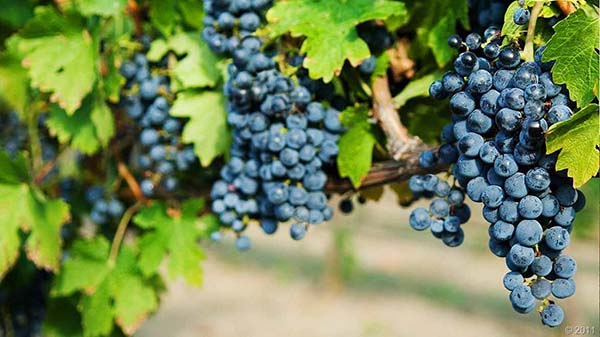
Content
- 1 The best black (blue) table grapes: top 15 most popular varieties (alphabetically)
- 1.1 Academician (In memory of Dzheneyev, Academician Avidzba)
- 1.2 Athos
- 1.3 Great
- 1.4 Viking
- 1.5 Rapture black (Brother of Rapture, Black Baron)
- 1.6 Gala
- 1.7 Fun
- 1.8 Codryanka
- 1.9 Kuban
- 1.10 Moldova
- 1.11 Nadezhda AZOS
- 1.12 Autumn black
- 1.13 In memory of Negrul
- 1.14 Rochefort
- 1.15 Sphinx
- 1.16 Other black table varieties
- 2 The best black (blue) technical grape varieties
- 3 The best black (blue) universal grape varieties
The best black (blue) table grapes: top 15 most popular varieties (alphabetically)
This crop category includes all grape varieties that have a fruit color ranging from blue to deep purple. In addition, most of them are characterized by a prune bloom over the skin.
Academician (In memory of Dzheneyev, Academician Avidzba)
Obtained by crossing the varieties Gift from Zaporozhye and Richelieu. Selection "Magarach" (Ukraine).
The bunches are large, cylindrical-conical, from loose to medium density. Weighing about 1 kg.
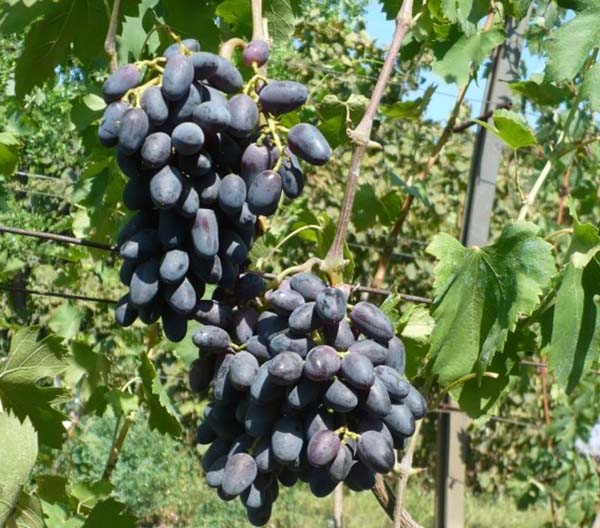
The berry is blue-black (dark blue), elongated-oval, measuring 33 by 20 mm. The skin is medium strength, the flesh is crispy. The taste is harmonious, dessert type.
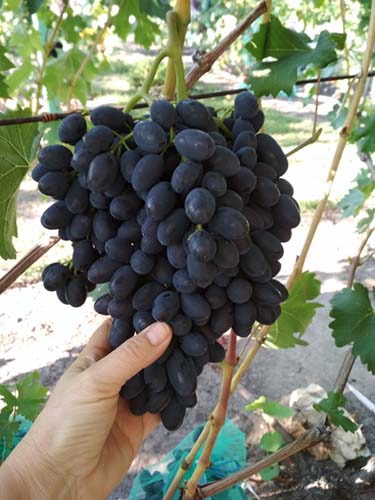
Characteristics of the Akademik variety:
- ripening period - 100-115 days (very early or very early);
- average yield - 20-25 t / ha;
- frost resistance up to -23-25 degrees.
Advantages:
- Excellent tasting score (9.8 points).
- Resistance to fungal diseases (mildew and oidium) is average.
- High transportability.
- Withstands the most severe overloads.
Disadvantages:
- Interesting wasps.
- The first bunch on the shoot has peas, the second does not. Therefore, in the spring it is necessary to remove the first inflorescence.
- Sometimes there are problems with pollination.
Athos
A hybrid form of amateur grape selection V.K. Bondarchuk, obtained from crossing the varieties Talisman and Kodryanka.
Not a bad earlier alternative to Codreanca.
Bushes above average vigor. The flower is bisexual.
The bunch is conical, large, weighing 500-700 g, medium density.
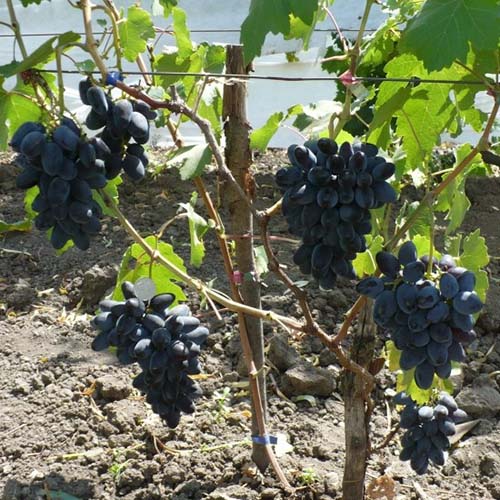
The berry is dark blue, oblong-ovoid, large, weighing 10-12 g. The peel is of medium thickness and density, the flesh is crispy, the taste is harmonious.
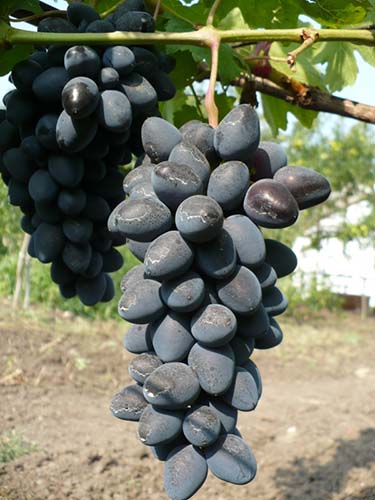
Characteristics of the Atos variety:
- ripening period - 95-100 days (very early);
- plant load with eyes - 30-35;
- pruning of fruiting vines is average - by 6-8;
- frost resistance up to -23 degrees.
Advantages:
- Increased resistance to fungal diseases (except for mildew).
- Ripening of the vine is excellent.
- Cuttings root very well
- No peas.
- Wasps are not damaged.
- Without loss of taste, it can hang on the bush for up to a month.
- High transportability.
Disadvantages:
- Often affected by mildew.
- Simple enough taste.
Great
Obtained by crossing the varieties Bolgar and Alphonse Lavalle. Bred by Ivan Todorov (Bulgaria).
The growth of the bushes is very strong (transgressive effect), which often forces the plant to form even in the year of planting. The flower is bisexual.
The clusters are large (18 x 13 cm), with an average weight of 500-600 g, from conical to cylindro-conical, loose.
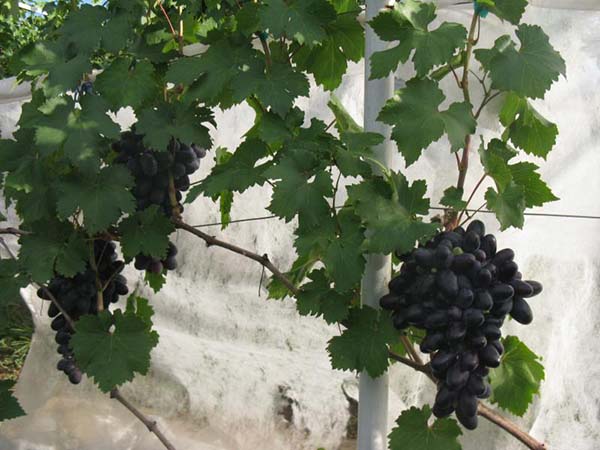
The berries are very large, with an average weight of 13-14 g (38.2x23 mm), elongated, slightly pointed towards the top, color from dark red to dark purple. The skin is thick, firm, and edible. The pulp is crispy, the taste is harmonious, reminiscent of the Bolgar variety. Seeds are medium in size, round pear-shaped, with a short beak, dark brown.
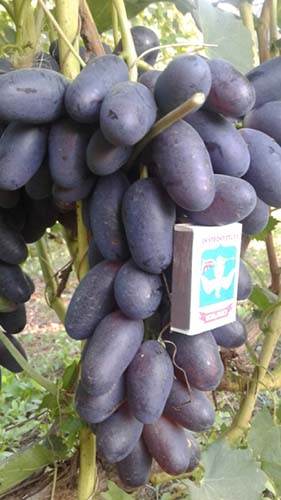
Characteristics of the Velika variety:
- ripening period - 130-140 days (average);
- yield - 9.8 kg per bush, 350 kg / ha;
- sugar content - 15-17%;
- acidity - 5 g / l;
- pruning fruit vine - 5-7 eyes;
- frost resistance up to -22 degrees.
The recommended type of shaping is a two-plane trellis.
Benefits:
- The berries do not crack.
- Wasps are not affected.
- The vine ripens perfectly.
- Disease resistance is average.
- Highly transportable.
- Stores relatively well in the refrigerator.
Has a good affinity with rootstocks CO4, 41B, Monticola. But rootstocks are recommended that inhibit the strong growth of the scion: Chassela x Berlandieri 41B, CO4, etc.
Disadvantages:
- In the north, it is highly susceptible to fungal diseases, primarily mildew.
Viking
A hybrid form of culture, obtained by crossing on the basis of the qualities of Codryanka and ZOS-1 (Red Rapture). Selections V.V. Zagorulko (Ukraine).
Differs in a very strong growth of shoots.
Forms conical clusters weighing 600-800 g, in especially fruitful years up to 1000 g. Their structure is medium-dry.

Fruits of a deep dark blue shade with a waxy coating on the skin. The berries are distinguished by a dessert taste and a slight aftertaste of prunes. Fruit weight is 8-12 g, their shape is elongated ovoid (usually 22 mm x 34 mm). The pulp has a dense juicy structure, the eaten skin is slightly palpable when consumed.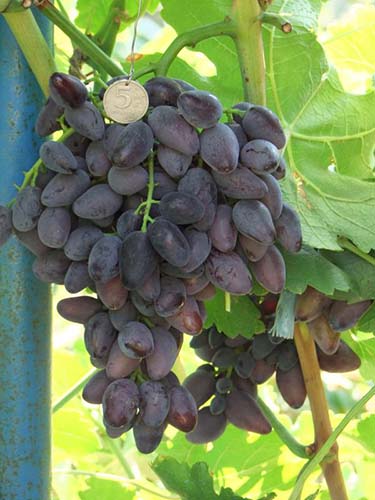
The main characteristics of the Viking variety:
- ripening period - 100-115 days (over early or very early);
- sugar accumulation - 16%;
- acid content - 4-6 g / l;
- needs a long pruning of 12-14 eyes;
- frost resistance up to -21 degrees.
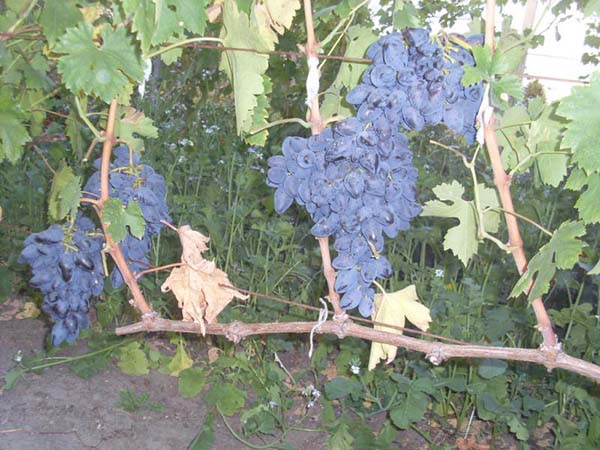
Benefits:
- Flowers are bisexual.
- It can hang on a bush and not deteriorate up to 1-1.5 months.
- High marketability.
- No peas.
- Good maturation of shoots.
- Resistance to major diseases: to mildew - 3.5-4 points, oidium - 3.0 points.
Disadvantages:
- With the tremendous strength of the bush, low fertility and, as a result, poor productivity.
- Prone to cracking of fruits with increased soil moisture.
- Due to its very high growth force, it is prone to fattening and has problems with the setting of fruit buds.
Rapture black (Brother of Rapture, Black Baron)
Obtained by a complex crossing of the Zarya Severa variety with Dolores and the Russian Early variety. Breeding VNIIViV them. ME AND. Potapenko (Russia).
Bushes are vigorous. The flowers are functionally feminine.
The bunches are very large 450-750 g, some up to 2-2.5 kilograms, cylindrical, moderately dense, loose, sometimes dense.
The berries are dark blue, large, 27x23 mm, weighing 7-8 grams, round or oval. The taste is simple. The pulp is fleshy, the skin is thick.
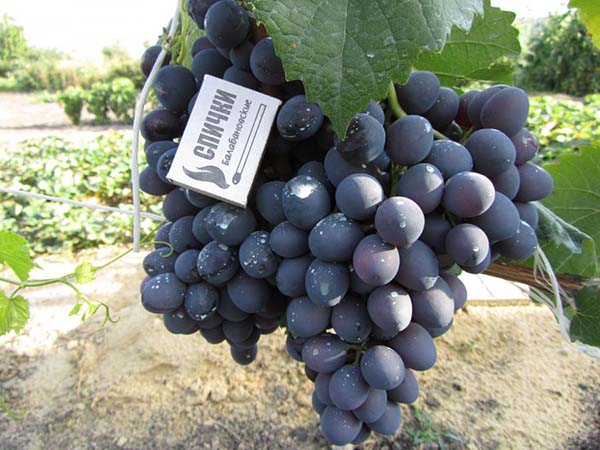
Characteristics of the Black Delight variety:
- ripening period - 115-125 days (early);
- sugar content - 16-18%;
- acidity 5-9 g / l;
- fruitful shoots - 75-85%;
- fertility coefficient - 1.3-1.6;
- load on the bush - 40-50 eyes;
- pruning vines - 10-12 eyes.
The fruitfulness of the eyes at the base of the shoots is high, so you can also carry out a short pruning of 3-4 eyes.
- frost resistance up to -25 degrees.
Advantages:
- It is pollinated well, any bisexual grape variety blooming at the same time can serve as a pollinator.
- Shoots ripen well.
- Cuttings root well.
- Resistant to mildew, oidium.
Disadvantages:
- There is a tendency to damage by gray mold.
- To obtain a good harvest, it is necessary to carry out precise agricultural techniques.
The variety requires an increased feeding area for bushes, powerful formations, rationing of the load of fruits and shoots. When the bushes thicken, the pollination of the inflorescences worsens. Before flowering, it is advisable to pinch the tops of the shoots.
Gala
The hybrid originated from the crossing of Kodryanka and Podarok Zaporozhye varieties. Selections V.V. Zagorulko (Ukraine).
The bushes are very vigorous.
Forms large cone-shaped grape clusters, their weight depends on agricultural technology and varies from 500 g to 1.5 kg.
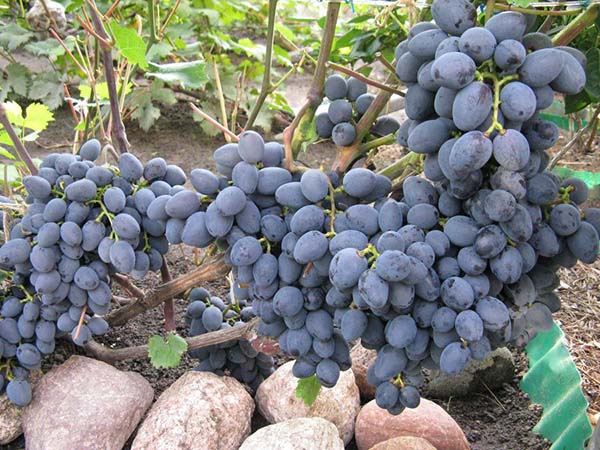
The structure of the bunches resembles the Black Delight grape variety.
The fruits are uniformly dark blue in color. Berries are oval, medium-dense, weighing from 7-10 g. It differs in crispy flesh, but the peel is almost imperceptible when used, the taste is quite simple (sweet and sour).
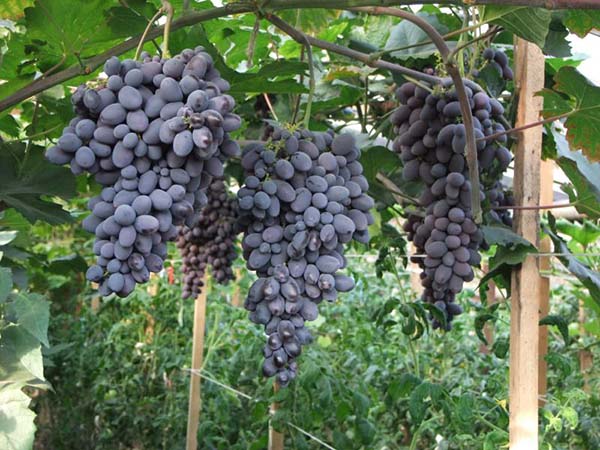
Characteristics of the Gala variety:
- ripening period - 110-115 days (very early);
- sugar ratio - 16.5%;
- acidity - 6-8 g / l;
- recommended load - 30-40 eyes;
- trimming - 6-8 eyes;
- frost resistance - up to -21 ..- 22 degrees.
Benefits:
- Tasting qualities - 8.6 points.
- The flower is bisexual.
- Resistant to fungal diseases: mildew, oidium, gray rot (3-3.5 points).
- Good transportability.
- No peas.
Disadvantages:
- It is necessary to normalize, otherwise (in case of overload) maturation is delayed (the acid will not leave).
Fun
Derived from crossing the varieties Laura and Codryanka. Selections V.V. Zagorulko (Ukraine).
According to many winegrowers, it is quite a suitable replacement for Codreanca.
Growth vigor of own-rooted bushes is great, leaf shape, like Laura's. The flower is bisexual.
The bunches are large, moderately dense, with an average weight of 600-1500 grams.
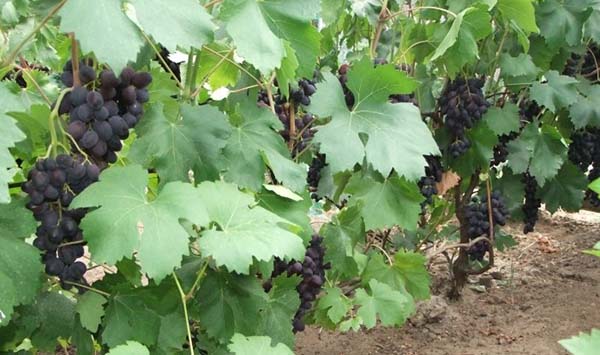
The berries are dark blue with a dense prune, large (7-12 g), oval-ovoid, with dense fleshy pulp of a harmonious taste (some call it "marmalade"). The berry contains 3-4 medium-sized seeds.
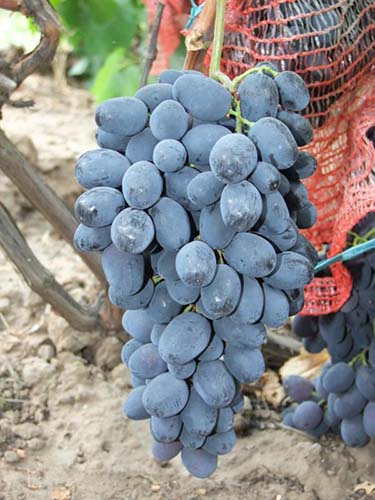
Characteristics of the variety Zabava:
- ripening period - 100-110 days (very early or very early);
- load on the bush - 30-35 eyes;
- pruning vines - 6-8 eyes;
- frost resistance up to -19-21 degrees.
Advice! To improve the quality of berries, green operations are necessary: removing weak shoots and all stepchildren, pinching the tops of fruiting shoots before flowering, rationing fertile shoots with extra inflorescences, removing leaves for good sun illumination of the bunch zone during the period of softening and ripening of berries.
Advantages:
- Wasps are not affected.
- No peas.
- Ripening of shoots is good.
- Cuttings root well.
- Compatible with most rootstocks.
- Disease resistance is average (3-3.5 points).
- The bunches have a very attractive presentation.
Disadvantages:
- It has a tendency to overload, so it is necessary to normalize the bushes with shoots and bunches.
Codryanka
The variety was bred by crossing the varieties of Moldova and Marshal. Breeding "Vierul" (Moldova).
It is characterized as a vigorous plant.
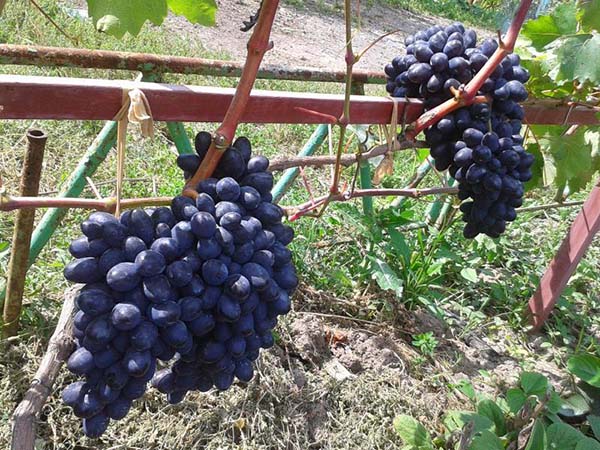
Grape clusters have an average weight of 400-600 g, but there are also individual ones up to 1200-1500 g. The structure is medium loose (moderately dense).
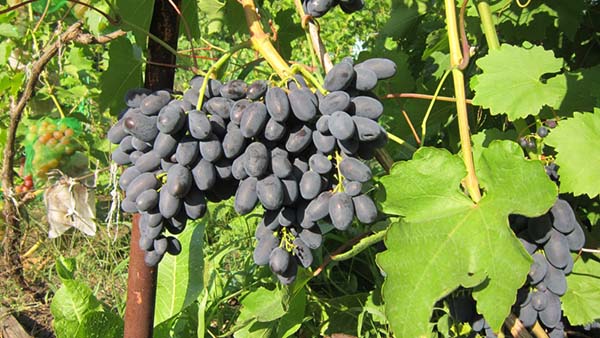
The berries are dark purple in color. Fruit weight - 6-8 g, shape - oval, average length - 31 mm, width - 19 mm. The taste is simple, but the flesh is crunchy, the easily separable bones and imperceptible rind, when used together, give a good tasting quality.
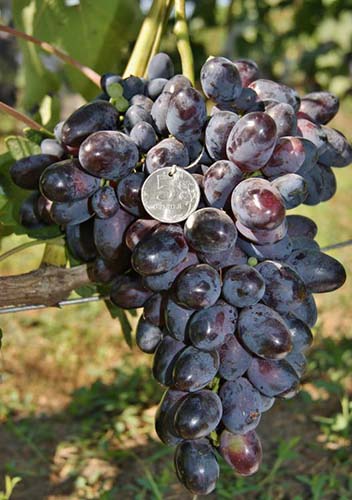
Characteristics of the Codryanka variety:
- ripening period - 110-120 days (very early or early);
- sugar accumulation - 18-19%;
- the ratio of acids is 6-7 g / l;
- fruitful shoots - 70-85%;
- the number of clusters per fruitful shoot - 1.2-1.7;
- the load on the bush during pruning is 40-50 eyes;
- trimming - for 8-10 eyes;
- frost resistance up to -22 - .. 24 degrees.
Note! Codryanka can be consumed even with incomplete accumulation of sugar in berries (12-14%), since this variety is characterized by a rapid decrease in acidity.
The advantages of the variety:
- Tasting score (8.2 points).
- Has increased resistance to gray rot, as well as to mildew and powdery mildew (3 points).
- Tolerant to phylloxera (grape aphid).
- Good maturation of shoots.
- It can hang on bushes for a long time without loss of taste.
- Excellent marketability and transportability.
- Weakly affected by wasps.
- Good keeping quality - suitable for short-term storage.
By the way! Responds well to gibberellin treatment.
Disadvantages:
- Possibly peas.
Important! It is rightfully one of the best, most popular and problem-free grape varieties.
Kuban
Obtained by crossing Moldova and Cardinal varieties. Selection AZOS (Russia).
The vigor of the bushes is above average or high. The flower is bisexual.
Bunches are very large 600-900 g, individual up to 1.5 kg, cylindrical, medium density.
The berries are dark blue, very large (30.8 x 25.2 mm), oval-ovoid, with an average weight of 6-12 g. The pulp is fleshy and juicy. Eatable peel. The taste is harmonious.
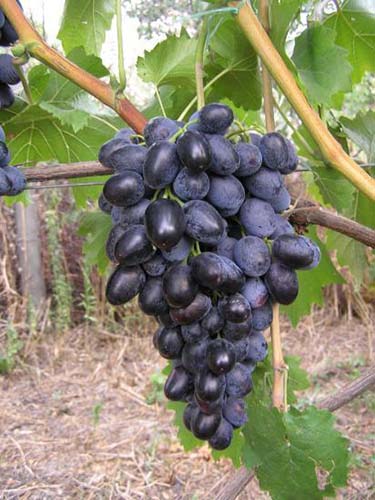
Characteristics of the Kuban variety:
- ripening period - 120-130 days (mid-early).
- sugar content - 16-20%;
- acidity - 5-9 g / l;
- fruitful shoots - 55-70%;
- the number of bunches per fruitful shoot - 1.0-1.2;
- load on the bush - 35-45 eyes;
- pruning fruit vines - for 8-10 eyes;
- frost resistance up to -22 ..- 23 degrees.
Advantages:
- High tasting score (8.4 points).
- Quite good resistance to fungal diseases (3.0-3.5 points).
- Does not burst.
- Not damaged by wasps.
- Shoots ripen well.
- It can be stored on bushes for a long time without losing its commercial quality.
- Can be used for storage.
- High transportability.
Disadvantages:
- There are small peas.
- Afraid of sunburn.
Moldova
The variety is obtained by crossing Villard Blanc and Guzal Kara. Breeding "Vierul" (Moldova).
Bushes are vigorous.
Suitable as a gazebo culture.
The leaves are rounded, five-lobed, poorly dissected. There is an edge on the reverse side of the leaf plates.
The clusters are cylindrical-conical, with an average level of density. The mass of the bunch is in the range of 400-600 g, but some are up to 1 kg.
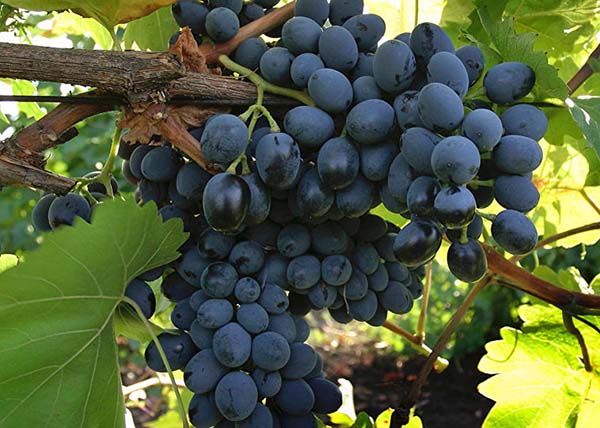
The fruits have an inky (dark purple) shade with a thick waxy coating. Berries are oval, 25 x 19 mm in size, weighing 5-6 grams. The pulp is dense, crispy, firm, and therefore felt when eaten. The taste is simple.
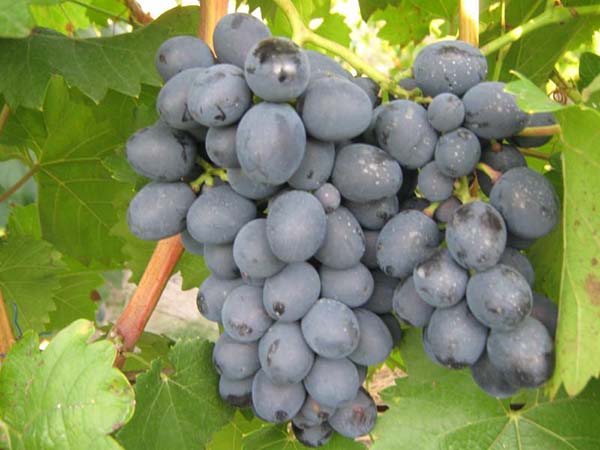
Characteristics of the Moldova variety:
- ripening period - 155-165 days (late);
- sugar accumulation -17-19%;
- acid content - 7-10 g / l;
- the ratio of fruitful shoots is 70-80%;
- the number of bunches - 1.4-1.8;
- load on the bush - 50-65 eyes;
- recommended pruning for 6-8 eyes;
- frost resistance up to -23 degrees.
Note! Moldova is not demanding on agricultural technology, but at the same time it has a high yield stability. However, with thickening of the plantings, the yield and quality of the fruits sharply decrease.
Benefits:
- Excellent tasting score (9.5 points).
- Differs in bisexual flowers.
- Begins to bear fruit early.
- Shoots ripen well.
- Resistant to mildew, gray mold, powdery mildew and phylloxera.
- Wasps are not damaged.
- Almost never peas.
- The berry does not crack under any circumstances.
- Stores well on bushes.
- High commercial quality.
- Well transported and stored.
Disadvantages:
- Susceptible to calcareous chlorosis.
- Susceptible to Phomopsis.
Nadezhda AZOS
Obtained by crossing Moldova and Cardinal varieties. Selection AZOS (Russia).
The growth force is great. The flower is bisexual.
The bunch is large and very large, weighing 600-900 g and larger. Medium density or loose, conical or branched.
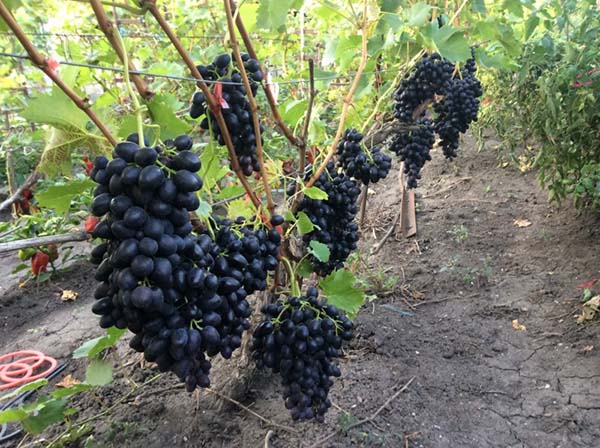
The berry is dark blue (purple), oval (29 x 23 mm), weighing 5-8 g or more. The pulp is firm and fleshy, crispy. The taste is simple but very harmonious.
Characteristics of the variety Nadezhda AZOS:
- ripening period - 120-130 days (early middle);
- sugar content - 15-17%;
- acidity - 7-8 g / l;
- fruitful shoots - 80-90%;
- the number of bunches per fruitful shoot - 1.2-1.6;
- load on the bush when pruning - 35-45 eyes;
- pruning fruit vines - for 8-10 eyes;
- frost resistance up to -22 ..- 23 degrees.
Advantages:
- Good resistance to fungal diseases (2.5-3.5 points): resistant to mildew, gray mold, increased resistance to powdery mildew.
- Ripening of shoots is good.
- Wasps are not damaged.
- It has high indicators of marketability and transportability.
- It can hang on the bush until frost, while not losing its taste.
Disadvantages:
- The cuttings are poorly rooted.
- It is prone to overloading the bush, while the clusters become smaller, normalization of the inflorescences and bunches is required.
Autumn black
Bred by crossing Alphonse Lavalle and Pierrelle.
Breeding "Vierul" (Moldova).
The bushes are medium or vigorous.
Bunches of medium density, conical (weighing 500-700 g).
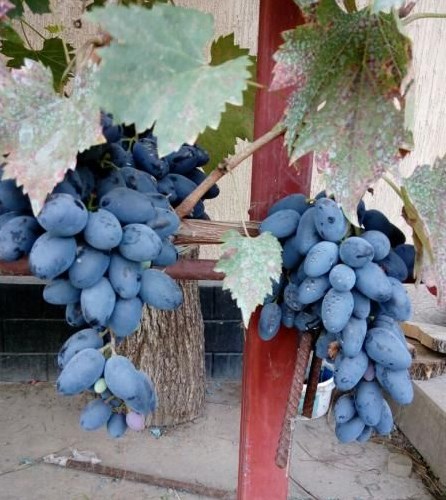
The berry is black with a prune bloom, oblong or obovate, large and very large (size 27 by 22 mm). Weighing 6-9 g. The taste is simple but harmonious.
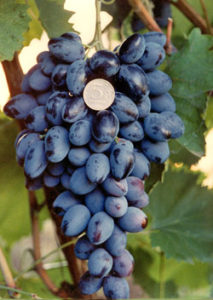
Characteristics of the Autumn Black variety:
- ripening period - 140-150 days (medium late or late);
- sugar - 16-18%;
- acidity - 7-8 g / l;
- on average, one shoot accounts for 1.3-1.5 inflorescences;
- fruitful shoots - 70-80%;
- the number of bunches per fruitful shoot - 1.1-1.5;
- load on the bush - 45-55 eyes;
- pruning length of fruit vines for 8-14 eyes;
- frost resistance up to -22 degrees.
Advantages:
- Differs in high productivity.
- Resistant to fungal diseases: mildew, oidium (2.5-3.5 points).
- Drought tolerant.
- Has good marketability and transportability.
- Suitable for long-term storage.
Disadvantages:
- With an excess of moisture, it is prone to cracking and gray mold damage.
In memory of Negrul
The variety was obtained by crossing Datie de Saint-Valier and Korn nagra. Breeding "Vierul" (Moldova).
Differs in vigorous bushes.
The size of the bunch reaches 20 cm in length, up to 12 cm in width, with a mass of 320 g, an average of 500-700 grams. The brushes are of medium density or loose.
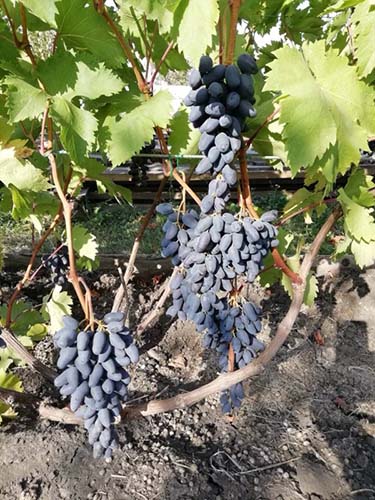
The berries have a dark purple uniform shade with a thick waxy bloom. In Memory of Negrul, berries have an elongated shape with a pointed end. Their dimensions are 30 by 19 mm, and their weight varies from 5 to 9 g. The taste is simple, but harmonious, there is a slight sourness. The flesh of the fruit is fleshy-juicy, crispy, the rind is firm and palpable, but edible. The number of seeds in a berry is about 2-3 pieces.
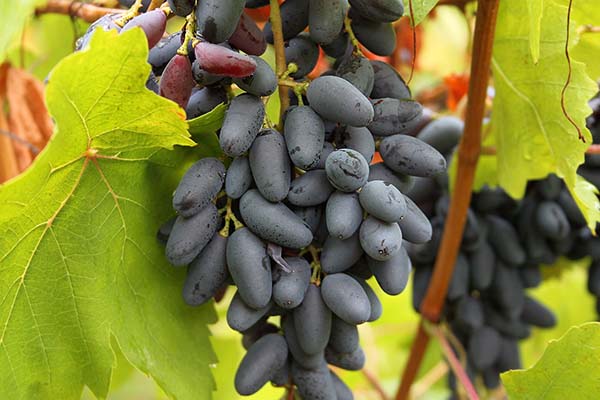
Characteristics of the variety in Memory of Negrul:
- ripening period - 145-160 days (late);
- sugar content - 14.3, but reaches 16-17%;
- acidity - 6-7 g / l;
- the coefficient of fruiting (fruiting shoots) - 60-70%;
- fertility coefficient (number of bunches per fruitful shoot) - 1.2;
- optimal load - 40-50 eyes;
- pruning vines is best done for 8-12 eyes;
- frost resistance up to -25 degrees.
Benefits:
- High tasting score (8.5 points).
- The flowers on the plant are bisexual, which guarantees a stable fruit ovary.
- Excellent presentation.
- It tolerates transportation very well.
- Stores well in the refrigerator.
- Good maturation of one-year vine.
- Wasps are not damaged.
- Possesses increased resistance to mildew, powdery mildew, gray rot
- Not affected by spider mites and leaf rollers, phylloxera.
Disadvantages:
- Demanding to agricultural technology - an increased load of eyes is required.
- Has a very brittle crest.
Rochefort
A hybrid form of amateur selection, by a complex crossing of the Talisman variety and the Cardinal variety with a mixture of pollen.
Great strength of growth. With a bisexual flower.
The bunches are medium, loose, weighing 300-400 g (individual 1 kg).
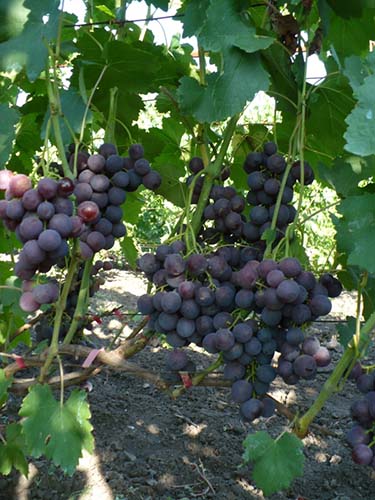
The berries are dark blue, rounded, 21.5 by 20.5 mm, with an average weight of 6-7 g (some up to 13-17 grams), Good harmonious taste, the skin is eaten, the flesh is fleshy.
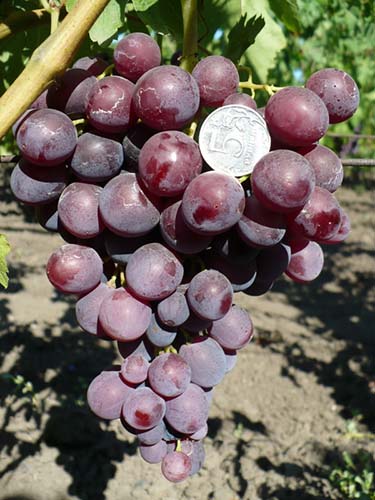
Rochefort characteristics:
- ripening period - 95-110 days (very early);
- sugar content of berry juice - 14.8 g / 100 cm3;
- acidity 5.6 g / dm3;
- frost resistance up to -15 ..- 18 degrees.
Advantages:
- Ripening of shoots is good.
- The berries can hang on the bush for a long time without cracking.
- The variety is not damaged by wasps.
- Has good resistance to mildew and gray mold.
Disadvantages:
- It is affected by powdery mildew.
Sphinx
The hybrid is bred on the basis of the Strashensky and Timur varieties. Selections V.V. Zagorulko (Ukraine).
It is characterized by great vigor of growth.
Forms large sheets of medium dissected shape.
Large grape clusters have a cylindro-conical shape with an average density, weighing up to 1 kg.
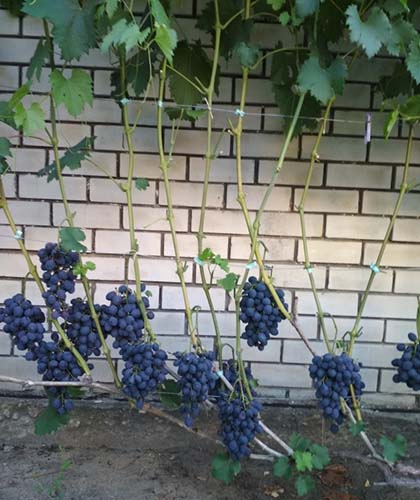
The size of the fruit is 28-32 mm (the shape can be oval or ovoid), weighing 6-9 grams. They are characterized by a crispy flesh with a firm rind, slightly palpable when eaten. Taste qualities are harmonious, there is a characteristic interesting varietal aroma.
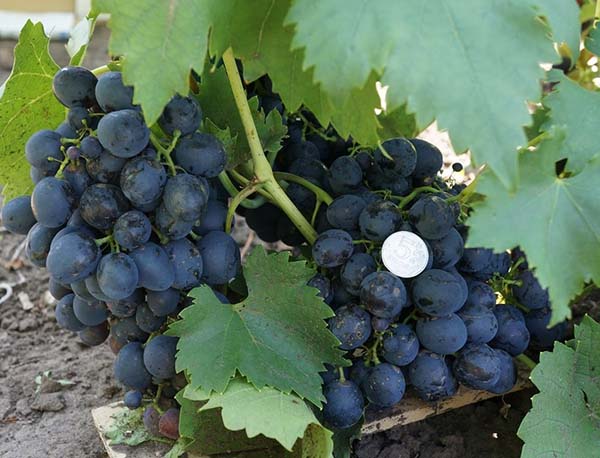
Characteristics of the Sphinx variety:
- ripening period - 100-105 days (very early);
- pruning vines is recommended for 4-6 eyes.
- frost resistance up to -23 degrees.
Advantages:
- It has bisexual flowers, which does not cause pollination problems.
- Ripening of one-year shoots is good.
- Cuttings root easily.
- There are almost no bunches of stepsons.
- Good resistance to mildew, powdery mildew, gray rot (3-3.5 points).
- High transportability.
Important! The buds of the Sphinx in spring bloom much later than similar varieties of culture, so return frosts cannot harm them.
Disadvantages:
- Cracking of berries in case of high humidity.
- Wasps sometimes attack.
Other black table varieties
Also quite popular and good varieties of table black (blue) grapes are:
- Galia;
- Dawn Unsvetaya;
- Zarif;
- Kishmish Zaporozhny;
- Unlight's Gift;
- Rhombus;
- Ruslan;
- Taboo (Comet);
- Natalia;
- Furor;
- Buffet;
- Black Finger (Black Finger);
- Black cherry;
- Black emerald;
- Miner;
- Esther;
- The effect.
The best black (blue) technical grape varieties
Of course, among the black grapes, there are many varieties that are designed to make wine:
August
The variety was bred on the basis of Kazachka and SV 12-309. Breeding VNIIViV them. ME AND. Potapenko (Russia).
Forms vigorous bushes.
Augustus has small (110-120 g) brushes of conical shape, dense and medium loose structure.
The berries are dark blue with a prune bloom. Round small fruits weigh 1.3-1.7 g. The taste qualities of the variety are harmonious with an unobtrusive note of nutmeg. The pulp of the fruit is juicy, fleshy, with a dense skin, the juice is not colored.
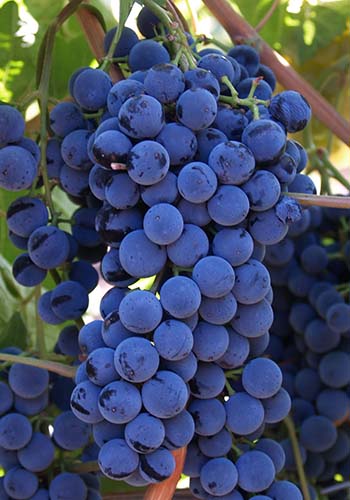
Characteristics of the Augusta variety:
- ripening period - 128-130 days;
- sugar content - 23-24%;
- acidity - 9 g / l;
- fruiting coefficient - 1.6;
- yield - 100-110 c / ha (with a planting scheme of 3 by 1.5 meters);
- optimal load - 20-25 eyes;
- permissible trimming - 3-4 eyes;
- winter hardiness up to -24 ... -25 degrees.
This grape is used for dry and dessert wines.
Advantages:
- Not a bad dry wine tasting score (7.5 points).
- High resistance to powdery mildew (1.5 points), good to mildew 2.5 points, to phylloxera 3.5 points.
- High rate of rooting of cuttings.
- Compatible with different rootstocks, but Kober 5BB or 101-14 is better.
Disadvantages:
- Very much stepson (chases stepsons just with terrible force).
He loves watering very much - there are more clusters, and without watering it grows very average.
Aliyevsky
Bred on the basis of the Viorica and Startovy varieties. Selections of the Moscow Agricultural Academy K. A. Timiryazeva.
Differs in medium or vigorous bushes.
The shade of a ripe young vine is nutty. Alievsky is distinguished by large, slightly dissected leaves with a strongly corrugated blade. On the reverse side of the leaf plates, there is a small bristly edge.
Aliyevsky has cylindro-conical dense brushes of medium size and weighing 130 g.
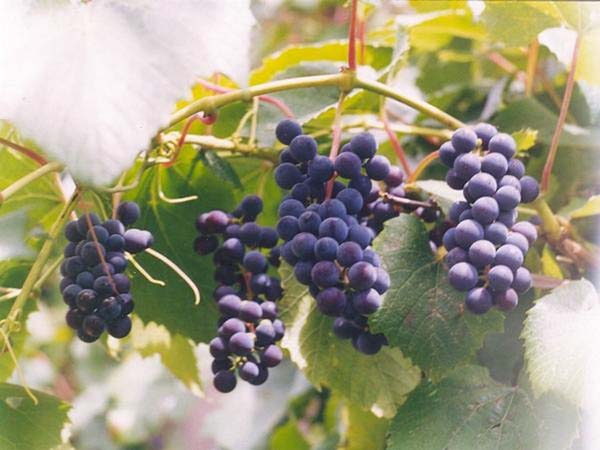
The color of the berries is blue-black. The pulp is juicy, soft, without aroma. The rind is firm.
Used for the preparation of dry and semi-sweet red wines.
Characteristics of the Alievsky variety:
- ripening period - 130-135 days;
- yield - 110-140 c / ha;
- the ratio of fruitful shoots - 85%;
- fertility coefficient - 1.5;
- optimal load - 45-50 kidneys;
- frost resistance up to -26 ..- 28 degrees.
Advantages:
- The flower is bisexual.
- Ripening of the vine is good.
- Resistant to major diseases.
Alpha
Bred in the USA by crossing V.labrusca x V.riparia.
The variety is characterized by medium and vigorous bushes.
Differs in large sharp-toothed three-lobed leaves with an average degree of dissection.
Forms medium-sized cylindrical or cylindrical-conical brushes with a dense to medium loose structure. The average weight of a bunch is 120 g, maximum - 220 g.
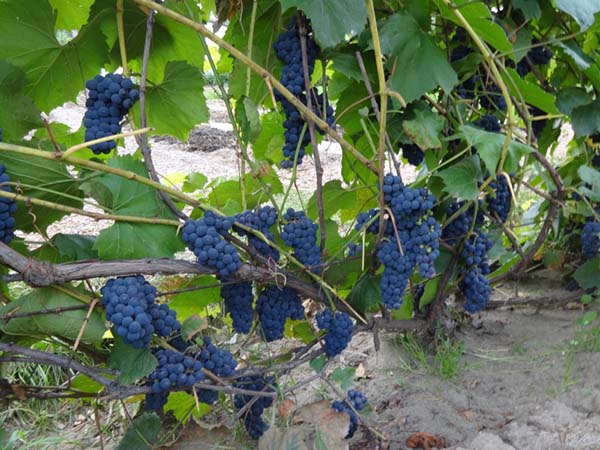
The color of the berries is black with a reddish-purple tint, and also covered with a thick waxy bloom. The fruits are round and medium in size. The skin is dense, firm, easily separated from the pulp. The mucous flesh of the berries has a pronounced very sharp sour taste, with a well-pronounced strawberry aroma, it is difficult to separate from the seeds.
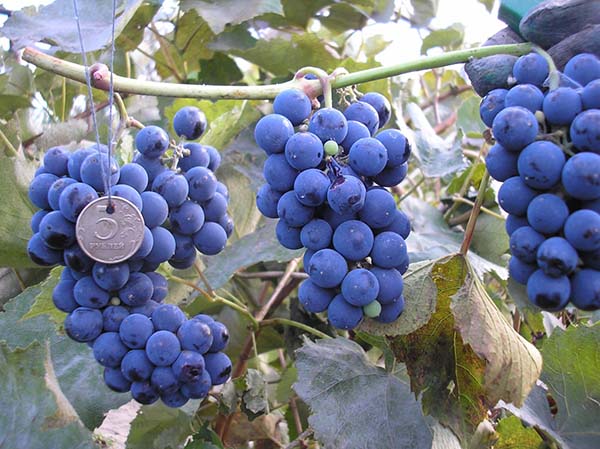
By the way! Alpha is great for landscaping gazebos, balconies and walls.
Characteristics of the Alpha variety:
- ripening period - 140-145 days;
- yield 150-180 c / ha;
- sugar content - 15-16%;
- acidity - 10-11 g / l.
Advantages:
- It is characterized by bisexual flowers, so pollination does not cause any difficulties.
- Weakly susceptible to diseases: relatively resistant to mildew, anthracnose.
- The ripening of the vine is very good.
- Perfect as a rootstock for varieties with low frost resistance.
Disadvantages:
- It is affected by spots and pests.
- High acidity.
Taiga
The bush is very vigorous. Female type of flower.
Can be used for landscaping.
Conical bunches, loose, small or medium, weighing up to 250 g.
The berries are dark blue, weighing 2.5-4 grams. With a light nutmeg aroma (sometimes there is a Labrusca flavor), it is very rich in pectin substances.
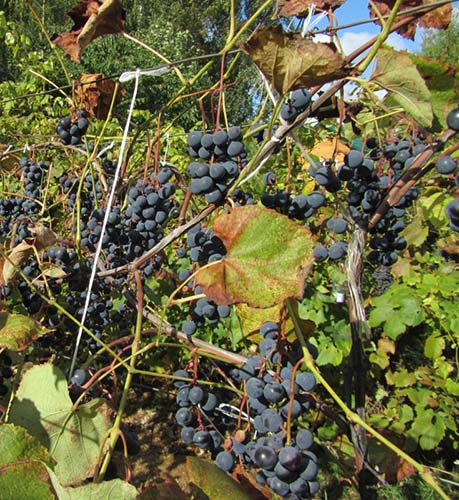
Characteristics of the Taezhny variety:
- ripening period - 130-135 days;
- the average number of clusters per shoot is 2.5-3.5.
- sugar accumulation - 17-24%
- frost resistance up to -28-35 degrees.
Advantages:
- High productivity.
- The berries can hang without decay (even in the rain) for 1.5 - 2.5 months.
- Comprehensively resistant to all fungal diseases.
Disadvantages:
- Still, sometimes it is struck by mildew.
- We need a pollinator, preferably Alpha.
- Due to overload, it picks up sugar poorly.
Other black wine varieties
Also among the black grape varieties for wine are:
- Alminsky;
- Bastardo Magarachsky;
- Vesta;
- Dove;
- Pomegranate Maharach;
- Danko;
- Ilyichevsky early;
- Ruby Golodrigi;
- Cabernet Dorsa;
- Cabernet Pearls Clogs;
- Cabernet Cortis;
- Cabernet Jura;
- Lada;
- Livadia black;
- Marshal Foch;
- Merlot;
- Muscat Blau;
- Don Muscat;
- Mendeleum;
- Odessa black;
- Regent;
- Rondo;
- Saperavi North;
- In memory of Golodriga;
- Pinotin;
- Tavkveri Magaracha;
- Early purple;
- Black Pearl.
The best black (blue) universal grape varieties
Also, among black grapes, there are universal varieties that are suitable both for fresh consumption and for making wine:
Isabel
Natural hybrid between Labrusca and Winifer species.
Isabella is characterized by vigorous bushes.
Ideal for landscaping gazebos and other buildings.
The leaves are three-lobed, large and medium in size, dark green saturated color. On the reverse side of the plates there is a bluish edge.
The berries are dark blue with a bluish tint. Grape clusters reach a mass of 140 g, their shape is cylindrical with wings, the structure is of medium density, in some cases loose.
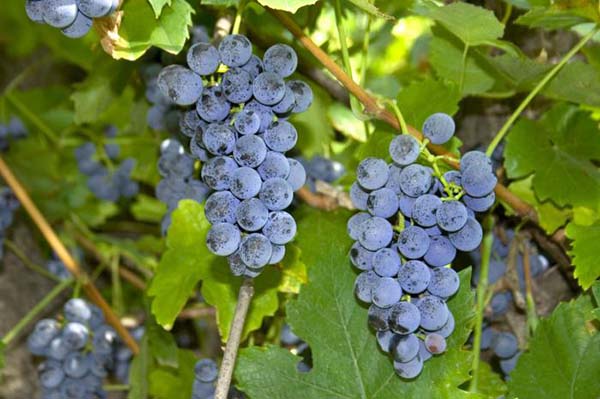
The fruits can be either oval or round, with a dense, firm skin. Isabella's flesh is slimy, with a pronounced strawberry aroma.
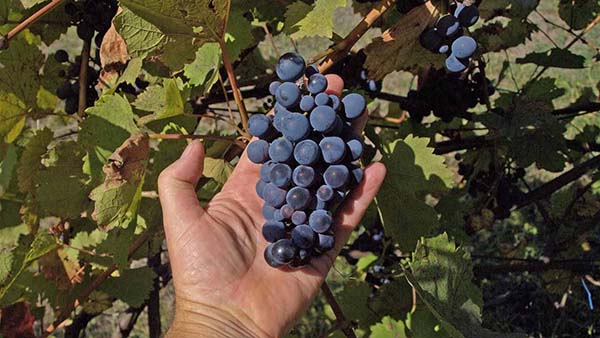
Suitable for both fresh consumption and for the preparation of ordinary wines.
Characteristics of the Isabella variety:
- ripening period - 150-180 days;
- sugar accumulation - 16-18%;
- acidity - 6-7 g / l.
- yield - 65-70 c / ha;
It prefers to grow on low-calcareous soils.
Advantages:
- The flowers are bisexual, which gives excellent self-pollination.
- Differs in high resistance against fungal diseases and phylloxera.
- It tolerates high humidity well.
By the way! Gives fruitful shoots from old wood and from replacement buds, which allows you to get a harvest even if the main (main) buds freeze.
Disadvantages:
- It does not tolerate drought very well (the growth force of the bush sharply decreases and leaves may fall).
Important! When the plantings are thickened, the grapes are affected by mildew.
Muscat of Hamburg (Muscat de Hamburg)
Obtained by crossing Frankenthal and Muscat of Alexandria. The variety was bred in England for greenhouse culture.
It is characterized by bushes of medium vigor.
The brush sizes reach 18-20 cm in length and 11-17 in width, conical in shape, branched, characterized by a loose structure. The weight of one bunch varies within 168-267 g. The stem of the bunch is of medium length (4-6 cm).
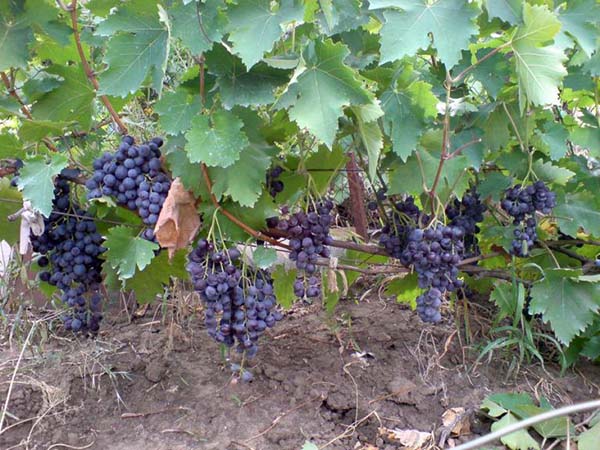
The berries are dark blue (violet-blue) with wax pollination. The fruits are round, less often oval, 12-26 mm long, 11-17 mm wide, 3-4 grams in weight. Their taste is pleasant, with a strong nutmeg flavor. Muscat of Hamburg has a juicy, fleshy pulp with a firm skin. There are 2-3 large seeds in the berry.
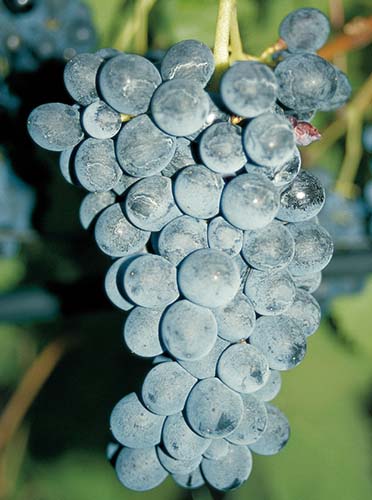
Compotes, juices, preserves and marinades made from berries of this variety are distinguished by their high taste.
Characteristics of the Muscat Gambursky variety:
- ripening period - 150 days;
- sugar accumulation 16-22%;
- acidity - 6-8 g / l;
- the ratio of fruitful shoots - 67%;
- bunch ratio - 1.58;
- frost resistance up to -18-19 degrees.
Note! This variety belongs to a group with potentially high, but very unstable yields.
Advantages:
- High tasting performance (9 points)
- The flowers are bisexual, which guarantees the ovary in any weather.
- It is almost not damaged by the grape leafworm.
- Wasps don't eat.
- It tolerates transportation well and can be stored for up to 2-3 months.
It grows well and bears fruit on the southern and southwestern slopes with light loamy, sandy loam and sandy soils.
Disadvantages:
- Very low frost resistance.
- Susceptible to almost all diseases, unstable to mildew, oidium, gray mold, bacterial cancer, phylloxera.
- Prone to peas.
- Annual shoots ripen satisfactorily, but with excess moisture and lack of heat it is bad.
Zilga
Bred on the basis of a complex crossing of the Smuglyanka variety with a mixture of pollen from Dvietes zila and Yubileiny Novgorod. Selections P. Sukatniek (Latvia).
Bushes are vigorous.
Note! The variety is great for gardening gazebos.
Brushes are cylindrical, large, weighing 320-400 g, often with a wing, generally have a dense structure, but sometimes they are loose.
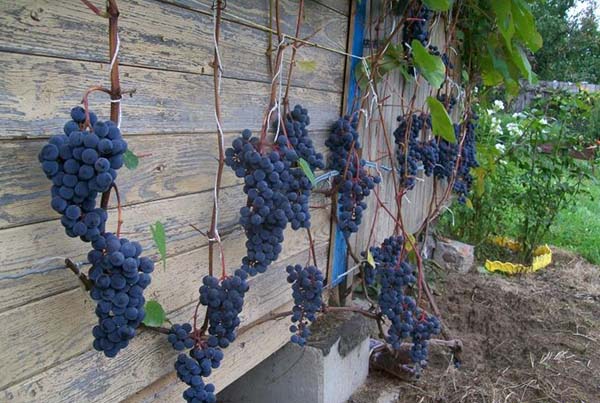
It has a uniform dark blue color. Oval fruits are large in size, weighing 4.1-4.3 grams. The flesh is slightly slimy, with a slight isable aroma.
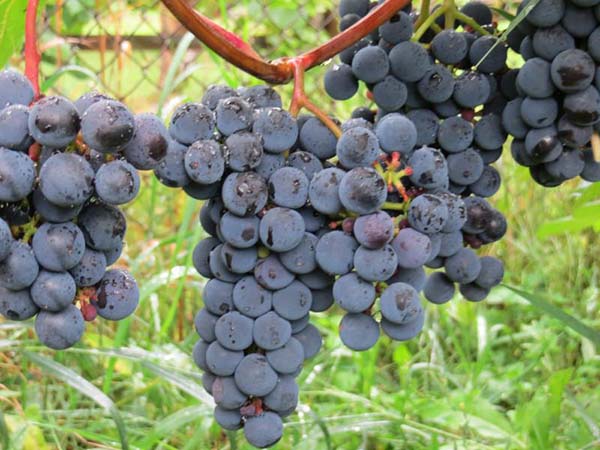
Characteristics of the Zilga variety:
- ripening period - 102-108 days;
- sugar accumulation - 18-22%;
- acidity - 4.5-5 g / l;
- the ratio of bunches is 1.5-1.9;
- shoots ratio - 80-85%;
- load - 30-40 eyes;
- optimal pruning of vines for 3-4 eyes;
- frost resistance up to -25 degrees.
Advantages:
- The crop is preserved for a long time on the bush without loss of quality.
- Resistant to major diseases (mildew, oidium and gray rot).
- Shoots ripen very well.
- Not damaged in transit.
- Compatible with different rootstocks.
Disadvantages:
- Average tasting assessment of the quality of fresh fruits (7.1 points).
Other versatile black grape varieties:
- Redness;
- Ruby Maharach.
Hopefully, after reading this article, you can easily decide which varieties of black grapes you should choose for planting in your garden or buy from the market to enjoy fresh berries, boil compote, make juice or make wine.

